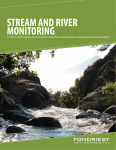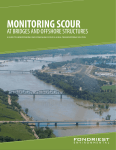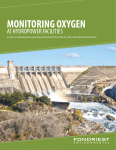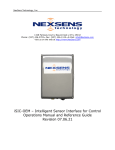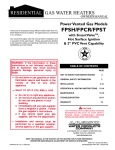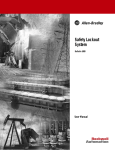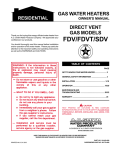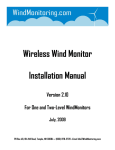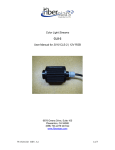Download A.O. Smith FDV Owner`s manual
Transcript
RESIDENTIAL GAS WATER HEATERS OWNER'S MANUAL DIRECT VENT GAS MODELS Thank you for buying this energy efficient water heater from A.O. Smith Water Products Company. We appreciate your confidence in our products. FDV TABLE OF CONTENTS PAGE GET TO KNOW YOUR WATER HEATER 2 GENERAL SAFETY INFORMATION 3 INSTALLATION 3 -8 OPERATION 8 -10 MAINTENANCE AND TROUBLESHOOTING 10 -11 WARRANTY 12 CAUTION TEXT PRINTED OR OUTLINED IN RED CONTAINS INFORMATION RELATIVE TO YOUR SAFETY. PLEASE READ THOROUGHLY BEFORE INSTALLING AND USING THIS APPLIANCE. A DIVISION OF A.O. SMITH CORPORATION www.hotwater.com KEEP THIS MANUAL IN THE POCKET ON HEATER FOR FUTURE REFERENCE WHENEVER MAINTENANCE ADJUSTMENT OR SERVICE IS REQUIRED. PRINTED IN U.S.A. 2560 999 1 PART NO. 183310-000 SUPERSEDES PART NO. 182857-000 REV. 1 GET TO KNOW YOUR WATER HEATER WARNING DO NOT ATTEMPT TO OPERATE WATER HEATER WITH COLD WATER INLET VALVE CLOSED. REPLACEMENT PARTS Replacement parts may be ordered through authorized servicers or distributors. Refer to the Yellow Pages for where to call or contact A. O. Smith Water Products Company, 5621 W. 115th Street, Alsip, IL 60803, 1-800-433-2545. When ordering parts, provide complete model and serial numbers (see rating plate), quantity and name of part desired (as listed in fig. 1). Standard hardware items may be purchased locally. INSERT A 2 INSPECT SHIPMENT INSULATION BLANKETS There may be hidden damage caused in transit. Check to be certain all parts of the venting system, as listed below, are present. Inspect the upper and lower air inlet boxes, rear air tube and all parts of the venting system. CAUTION!!! IF THERE ARE ANY DAMAGED PARTS, DO NOT INSTALL THIS WATER HEATER. REPORT ANY SHORTAGE TO YOUR DISTRIBUTOR OR DAMAGE TO YOUR CARRIER. Insulation blankets available to the general public for external use on gas water heaters are not necessary with A. O. Smith products. The purpose of an insulation blanket is to reduce the standby heat loss encountered with storage tank water heaters. Your A. O. Smith water heater meets or exceeds the National Appliance Energy Conservation Act standards with respect to insulation and standby loss requirements, making an insulation blanket unnecessary. VENT KIT ASSEMBLY COMPONENTS 1 1 1 1 1 1 1 1 8 — — — — — — — — — WARNING Should you choose to apply an insulation blanket to this heater, you should follow these instructions (See Figure 1 for identification of components mentioned below). Failure to follow these instructions can restrict the air flow required for proper combustion, resulting in fire, asphyxiation, serious personal injury or death. • Do not cover the outer door, thermostat or temperature & pressure relief valve. • Do not cover the instruction manual. Keep it on the side of the water heater or nearby for future reference. • Do obtain new warning and instruction labels from A.O. Smith for placement on the blanket directly over the existing labels. 3" 90° steel elbow 5" 90° aluminum elbow 3" tube assembly (2-pcs. meshed) 5" tube assembly (2-pcs. meshed) Finishing collar (inside) Finishing collar (outside) Terminal Vent Cap Assembly Tube silicone sealant Sheet metal screws GENERAL SAFETY INFORMATION INSTALLATION EXTERNAL DAMAGE REQUIRED ABILITY Do not operate the water heater until it has been fully checked out by a qualified technician, if the water heater: INSTALLATION OR SERVICE OF THIS WATER HEATER REQUIRES ABILITY EQUIVALENT TO THAT OF A LICENSED TRADESMAN IN THE FIELD INVOLVED. PLUMBING, AIR SUPPLY, VENTING AND GAS SUPPLY ARE REQUIRED. • Has been exposed to fire or damage. • Displays evidence of sooting. • Produces steam or unusually hot water. If the water heater has been flooded it must be replaced. GENERAL CHEMICAL VAPOR CORROSION The installation must conform to these instructions and the local code authority having jurisdiction. In the absence of local codes, conform to the latest edition of National Fuel Gas Code ANSI Z223.1 The code manual can be purchased from the American Gas Association Laboratories, 8501 East Pleasant Valley Road, Cleveland, OH 44131. WARNING CORROSION OF THE FLUEWAYS AND VENT SYSTEM MAY OCCUR IF AIR FOR COMBUSTION CONTAINS CERTAIN CHEMICAL VAPORS. SUCH CORROSION MAY RESULT IN FAILURE AND RISK OF ASPHYXIATION. LOCATION OF HEATER Spray can propellants, cleaning solvents, refrigerator and air conditioning refrigerants, swimming pool chemicals, calcium and sodium chloride (water softener salt), waxes and process chemicals are typical compounds which are potentially corrosive. This is a direct vent water heater which draws combustion air from outside the structure and exhausts all products of combustion to the outside of the structure. All air for combustion and all products of combustion are routed through the ducting provided, directly from and to the outside of the building. It therefore must be located next to the outside wall within the range of the adjustments illustrated in fig. 15. DO NOT attempt to extend the air supply tube or inner flue vent tube beyond the dimensions specified on page 7 vent connections, steps 6 and 7. Do not store products of this sort near the heater. Also, air which is brought in contact with the heater should not contain any of these chemicals. If necessary, uncontaminated air should be obtained from remote or outside sources. The limited warranty is voided when failure of water heater is due to a corrosive atmosphere. (Refer to the limited warranty for complete terms and conditions). The heater is design certified by the American Gas Association for installation on combustible flooring in a closet having minimum clearances from combustible material of: 0" clearance from sides, rear, and top air tube, 4" from the front and 18" from the top. If clearances stated on the heater differ from standard clearances, install water heater according to clearances stated on heater. EXTENDED NON-USE PERIODS WARNING HYDROGEN GAS CAN BE PRODUCED IN A HOT WATER SYSTEM SERVED BY THIS HEATER THAT HAS NOT BEEN USED FOR A LONG PERIOD OF TIME (GENERALLY TWO WEEKS OR MORE). HYDROGEN GAS IS EXTREMELY FLAMMABLE. To reduce the risk of injury under these conditions, it is recommended that the hot water faucet be opened for several minutes at the kitchen sink before using any electrical appliance connected to the hot water system. If hydrogen is present, there will probably be an unusual sound such as air escaping through the pipe as the water begins to flow. THERE SHOULD BE NO SMOKING OR OPEN FLAME NEAR THE FAUCET AT THE TIME IT IS OPEN. A minimum clearance of 4" must be allowed for access to replaceable parts such as the thermostats, drain valve and relief valve. Adequate clearance for servicing this appliance should be considered before installation, such as changing the anodes, etc. When installing the heater, consideration must be given to proper location. The water heater should be located as close to or centralized to the water piping system as possible. The water heater should be located in an area not subject to freezing temperatures. 3 4. When the system requires water for space heating at temperatures higher than required for domestic water purposes, a tempering valve must be installed. Please refer to Fig. 2 for suggested piping arrangement. THE HEATER SHOULD BE LOCATED IN AN AREA WHERE LEAKAGE OF THE TANK OR CONNECTIONS WILL NOT RESULT IN DAMAGE TO THE AREA ADJACENT TO THE HEATER OR TO LOWER FLOORS OF THE STRUCTURE. When such locations cannot be avoided, a suitable drain pan should be installed under the heater. Such pans should have a minimum length and width of at least 2 inches greater than the diameter of the heater and should be piped to an adequate drain. Drain pans suitable for these heaters are available from your dealer or A. O. Smith Water Products Company, 5621 W. 115th Street, Alsip, IL 60803. CLOSED WATER SYSTEM A closed system will exist if a back-flow preventer (check valve), pressure reducing valve, or other similar device is installed in the cold water line between the water heater and the street main (or well). Excessive pressure may develop due to the thermal expansion of heated water causing premature tank failure or intermittent relief valve operation. This type of failure is not covered by the limited warranty. An expansion tank may be necessary in the cold water supply to alleviate this situation, see fig. 1. Contact the local plumbing authority. Under no circumstances is the manufacturer to be held liable for any water damage in connection with this water heater. WARNING DO NOT INSTALL THIS WATER HEATER DIRECTLY ON A CARPETED FLOOR. A FIRE HAZARD MAY RESULT. Instead the water heater must be placed on a metal or wood panel extending beyond the full width and depth by at least 3 inches (76.2mm) in any direction. If the heater is installed in a carpeted alcove or closet, the entire floor shall be covered by the panel. , If the temperature and pressure relief valve on the appliance discharges periodically, this may be due to thermal expansion in a closed water supply system. Contact the water supplier or local plumbing inspector on how to correct this situation. DO NOT PLUG THE TEMPERATURE AND PRESSURE RELIEF VALVE. GAS CONNECTIONS The minimum gas supply pressure is 4.5" water column for input adjustment. THE HEATER IS NOT INTENDED FOR OPERATION AT HIGHER THAN 14" WATER COLUMN (3.5 kPa) SUPPLY PRESSURE. EXPOSURE TO HIGHER GAS SUPPLY PRESSURE MAY CAUSE DAMAGE TO THE CONTROL WHICH COULD RESULT IN FIRE OR EXPLOSION. If overpressure has occurred such as through improper testing of gas lines or emergency malfunction of the supply system, the control must be checked for safe operation. Make sure that the outside vents on the supply regulators and the safety vent valves are protected against blockage. These are parts of the gas supply system not the heater. Vent blockage may occur during ice storms. IT IS IMPORTANT TO GUARD AGAINST CONTROL FOULING FROM CONTAMINANTS IN THE GAS WAYS. SUCH FOULING MAY CAUSE IMPROPER OPERATION, FIRE OR EXPLOSION. WATER CONNECTIONS All piping must comply with local codes and ordinances or with the latest edition of National Fuel Gas Code (ANSI Z223.1 NFPA-54) whichever applies. Refer to figure 1 for typical installation. A suitable pipe thread sealant must be used to prevent leakage. REFER TO FIG. 1 FOR CONNECTION DETAILS. BEFORE ATTACHING THE GAS LINE BE SURE THAT ALL GAS PIPE IS CLEAN ON THE INSIDE. WATER (POTABLE) HEATING AND SPACE HEATING 1. All piping components connected to this unit for space heating applications shall be suitable for use with potable water. 2. Toxic chemicals, such as those used for boiler treatment, shall NEVER be introduced into this system. 3. This unit may NEVER be connected to any existing heating system or component(s) previously used with a non-potable water heating appliance. TO TRAP ANY DIRT OR FOREIGN MATERIAL IN THE GAS SUPPLY LINE, A DIRT LEG (SOMETIMES CALLED DRIP LEG) MUST BE INCORPORATED IN THE PIPING, FIG. 1. The dirt leg must be readily accessible. Install in accordance with recommendations of serving gas supplier. Refer to the latest edition of the National Fuel Gas Code ANSI Z223.1. 4 To prevent damage, care must be taken not to apply too much torque when attaching gas supply pipe to thermostat gas inlet. The thermostat inlet has a pad for use with a backup wrench. VENT PIPE TERMINATION Before installing water heater determine placement of vent pipe termination. Apply joint compounds (pipe dope) sparingly and only to the male threads of pipe joints. Do not apply compound to the first two threads. Use compounds resistant to the action of liquefied petroleum gases. Do not use teflon tape on thermostat fittings. MAKE CERTAIN TO OBSERVE VENT LOCATION LIMITATION, SEE FIG'S 3 & 15. CAUTION Use only the vent kit assembly supplied with this water heater. Only supplied kit provides required clearances from combustibles; both through the wall and the exterior siding. TERMINATION OF A SIDEWALL VENT SYSTEM WITH A DEVICE OTHER THAN THE SUPPLIED VENT KIT ASSEMBLY IS NOT RECOMMENDED AND COULD AFFECT SYSTEM PERFORMANCE AND RESULT IN A SAFETY HAZARD. DISCONNECT THE APPLIANCE FROM THE GAS SUPPLY PIPING SYSTEM DURING ANY SUPPLY PRESSURE TESTING EXCEEDING 1/2 PSI (3.5 kPa). GAS SUPPLY LINE MUST BE CAPPED WHEN DISCONNECTED FROM THE HEATER. FOR TEST PRESSURES AT 1/2 PSI (3.5 kPa) OR LESS, THE APPLIANCE NEED NOT BE DISCONNECTED, BUT MUST BE ISOLATED FROM THE SUPPLY PRESSURE TEST BY CLOSING THE MAIN MANUAL GAS VALVE. IMPORTANT The vent system must terminate so that proper clearances are maintained as cited in local codes or the latest edition of the National Fuel Gas Code, ANSI Z223.1, 7.3.4e and 7.8c as follows: 1. The vent terminals of a direct vent system shall be not less than 7 feet above grade when located adjacent to public walkways (Fig. 3). 2. A venting system shall terminate at least 9 inches above any forced air inlet located within 10 feet (Fig. 3). 3. The venting system shall terminate at least 9 inches below, 9 inches horizontally from or 9 inches above any door, window or gravity air inlet into any building. 4. The manufacturer also recommends the vent terminations not be installed closer than 3 feet from an inside corner of an L shaped structure, and not less than 1 foot above grade. The vent shall terminate a minimum 12" above expected snowfall level to prevent blockage of vent termination. Check the metal tag on the relief valve and compare it to the heater’s rating plate. The pressure rating of the relief valve must not exceed the working pressure shown on the rating plate of the heater. In addition, the hourly BTU rated temperature steam discharge capacity of the relief valve shall not be less than the input rating of the heater. NO VALVE IS TO BE PLACED BETWEEN THE RELIEF VALVE AND TANK. DO NOT PLUG THE RELIEF VALVE. 5. In cold climates, it is recommended that vent termination not be mounted directly above or within 3 feet horizontally from an oil tank vent or gas meter to avoid potential freeze-up from condensation. The drain line connected to this valve must not contain a reducing coupling or other restriction and must terminate near a suitable drain to prevent water damage during valve operation. The discharge line shall be installed in a manner to allow complete drainage of both the valve and line. DO NOT THREAD, PLUG OR CAP THE END OF THE DRAIN LINE. Required clearances from combustible materials must be provided in accordance with information in this manual under LOCATION OF HEATER and with the National Fuel Gas Code and local codes. BEFORE PLACING THE HEATER IN OPERATION, CHECK FOR GAS LEAKAGE. USE SOAP AND WATER SOLUTION OR OTHER MATERIAL ACCEPTABLE FOR THIS PURPOSE. DO NOT USE MATCHES, CANDLES, FLAME OR OTHER SOURCES OF IGNITION TO LOCATE GAS LEAKS. RELIEF VALVE A NEW TEMPERATURE AND PRESSURE RELIEF VALVE COMPLYING WITH THE STANDARD FOR RELIEF VALVES AND AUTOMATIC GAS SHUT OFF DEVICES FOR HOT WATER SUPPLY SYSTEMS, ANSI Z21.22 (LATEST EDITION) MUST BE INSTALLED IN THE HEATER IN THE MARKED OPENING PROVIDED (SEE FIGURE 1). THE VALVE MUST BE OF A SIZE (INPUT RATING) THAT WILL BE ADEQUATE FOR YOUR SIZE HEATER. Plan the vent system layout so that proper clearances are maintained from plumbing and wiring. Carefully read through these installation instructions before you start your installation. The figures provided will give the necessary views to complete this installation. Self drilling screws are provided, but it may be necessary to use a 1/8" drill for a starting hole as called for in the instructions. VENTING NOTE: IN SOME LOCALITIES, LOCAL CODE REQUIRES AN ADDITIONAL VENT COVER. WARNING NEVER OPERATE THE HEATER UNLESS IT IS VENTED TO THE OUTDOORS AND HAS ADEQUATE AIR SUPPLY TO AVOID RISKS OF IMPROPER OPERATION, FIRE, EXPLOSION OR ASPHYXIATION. NOTE: The four fasteners that are required to secure the vent cap to the external wall are not provided. These should be screw type (not nails) chosen for the type of construction and obtained locally. DO NOT OBSTRUCT THE FLOW OF COMBUSTION AND VENTILATING AIR. ADEQUATE AIR FOR COMBUSTION AND VENTILATION MUST BE PROVIDED FOR SAFE OPERATION. 5 RECOMMENDED CLEARANCE NOT REQUIRED BY CODE. POSSIBLE PILOT OUTAGE IF LESS THAN 3' AND WINDY CONDITIONS EXIST. 2. Move the water heater to its final installed location. Make certain clearances from combustible material are observed. See figure 6. VENT CONNECTIONS Before proceeding, refer to figure 4 for schematic of how venting must be installed. Please note that the centerline of opening for the vent termination must be 67-7/8" above the surface upon which the water heater will be resting. If the heater will be placed on a stand, be sure to measure the 67-7/8" from the level of the stand upon which the heater will be resting. . FIGURE 5 3. Apply high temperature silicone sealant around flue extension inside of flared end. WARNING: IF YOU RUN OUT OF HIGH TEMPERATURE SILICONE SEALANT, USE NATIONAL POLYMER PRODUCTS, SEALCON II, RTV ADHESIVE SEALANT OR EQUIVALENT MUST CONFORM TO MIL-A46106A TYPE 1. DO NOT USE ANY OTHER KIND. Place the 3 inch steel elbow on the water heater flue pipe and press it firmly downward until sealed and pointed in the desired direction. See figure 7. FIGURE 4 After the location for the vent terminal has been selected: 1. Cut a clearance hole, (BEWARE OF CONCEALED WIRING AND PIPING INSIDE OF WALL), approximately 6 inches in diameter, through the exterior wall for the 5 inches diameter air tube. See figure 5. Basement installations generally require an additional leg stand kit (18" water heater stand) or a job fabricated stand to raise the heater to the proper height for exterior venting. Outside terminal vent cap must not be less than 12" above the ground. In heavy snow areas, the minimum 12" clearance should be increased accordingly. FIGURE 6 4. Install the 5 inch aluminum elbow over the 3 inch steel elbow. Be certain both are pointed in the desired direction with the 3 inch centered inside the 5 inch elbow. See figure 8. 6 FIGURE 7 FIGURE 10 5. As an aid to leveling the 5 inch elbow, temporarily place the 5 inch sliding tube onto the elbow. When leveled, drill a 1/8 diameter hole through the elbow into the collar at the front and back. Secure with the two #8 sheet metal screws provided. See figure 9. 8. From the outside of the building, insert the 5 inch tube/base assembly through the hole in the exterior wall and onto the 5 inch elbow. Then seal the base onto the wall. See figure 12. Place the finishing collar on the 5 inch elbow, as it will be positioned later. FIGURE 11 9. Next place the 3 inch main tube fully onto the collar of the vent cap. Then seat the cap against the base. FIGURE 8 6. Extend the 3 inch tube assembly to its maximum installed length, 20-3/4 inches. A minimum of 1-1/4" overlap is required at all 3" vent pipe joints. Place the larger main section through the hole in the external wall to the outside. Place the inner sliding section fully onto the 3 inch elbow. Apply high temperature silicone sealant as shown in fig. 10. FIGURE 12 10. Secure the vent cap/base assembly to the exterior wall with four screw anchors appropriate for the type of wall construction. The 5 inch tube should be essentially level. However, a small amount of upward or downward pitch will not affect operation. 11. Apply silicone caulking compound around the junction of the vent terminal base and the exterior wall. 12. Position and fasten the finishing collar, previously installed on the 5 inch elbow, against the wall to close the opening around the tube. FIGURE 9 7. Attach the 5 inch main tube to the vent terminal base. Drill a 1/8 inch hole through the tube into the collar of the base. Secure with a #8 sheet metal screw, furnished. Repeat with a second hole and screw approximately 180° from the first. Reinstall the 5 inch inner sliding section at its maximum extended length, 19-3/4 inches. See figure 11. 13. Make certain the 5 inch tube sliding section has been fully engaged onto the 5 inch elbow. Drill two each 1/8 inch holes (180° apart) in the junction of the two joints in the five inch tube. Fasten with four #8 sheet metal screws, furnished. 7 OPERATION NEVER OPERATE THE HEATER WITHOUT FIRST BEING CERTAIN IT IS FILLED WITH WATER AND A TEMPERATURE AND PRESSURE RELIEF VALVE IS INSTALLED IN THE RELIEF VALVE OPENING OF THE HEATER. DO NOT ATTEMPT TO OPERATE HEATER WITH COLD WATER INLET VALVE CLOSED. FILLING 1. Close the heater drain valve (Fig. 1) by turning handle clockwise. 2. Open a nearby hot water faucet to permit the air in the system to escape. 3. Fully open the cold water inlet pipe valve (Fig. 1) allowing the heater and piping to be filled. 4. Close the hot water faucet as water starts to flow. 5. The heater is ready to be operated. FIGURE 13 14. Seal all the 5 inch tube joints with silicone sealant including the elbow joint to the collar on the heater's air supply box. HIGH ALTITUDE INSTALLATIONS WARNING INSTALLATIONS ABOVE 2,000 FT. REQUIRE REPLACEMENT OF THE BURNER ORIFICE IN ACCORDANCE WITH THE NATIONAL FUEL GAS CODE (ANSI Z 223.1/NFPA 54). FAILURE TO REPLACE THE ORIFICE COULD RESULT IN IMPROPER AND INEFFICIENT OPERATION OF THE APPLIANCE, PRODUCING CARBON MONOXIDE GAS IN EXCESS OF SAFE LIMITS, WHICH COULD RESULT IN SERIOUS PERSONAL INJURY OR DEATH. CONTACT YOUR GAS SUPPLIER FOR ANY SPECIFIC CHANGES WHICH MAY BE REQUIRED IN YOUR AREA. A. O. Smith builds models specifically for high altitude service. Please check the rating plate before making changes. FIGURE 14 TEMPERATURE REGULATION 15. The fixed installation height is 67-7/8 inches from the surface that the heater rests on to the center of the vent tube. Do not attempt to extend the air supply tube beyond the dimensions shown (10" max.). Contact your supplier if additional information is needed before starting installation. DANGER THIS WATER HEATER IS EQUIPPED WITH AN ADJUSTABLE THERMOSTAT TO CONTROL WATER TEMPERATURE. HOT WATER TEMPERATURES REQUIRED FOR AUTOMATIC DISHWASHER AND LAUNDRY USE CAN CAUSE PAINFUL SCALDING WITH POSSIBLE SERIOUS AND PERMANENT INJURY. THE TEMPERATURE AT WHICH INJURY OCCURS VARIES WITH THE PERSON’S AGE AND THE TIME OF THE EXPOSURE. THE SLOWER RESPONSE TIME OF CHILDREN, AGED OR DISABLED PERSONS INCREASES THE HAZARDS TO THEM. NEVER ALLOW SMALL CHILDREN TO USE A HOT WATER TAP, OR TO DRAW THEIR OWN BATH WATER. NEVER LEAVE A CHILD OR DISABLED PERSON UNATTENDED IN A BATHTUB OR SHOWER. GAL. 40 50 E - REAR VENTING MIN. MAX. 4-1/8" 14-1/8" 3-1/8" 13-1/8" F - SIDE VENTING** MIN. MAX. 9-1/8" 20-1/8" 8-1/8" 18-1/8" THE WATER HEATER SHOULD BE LOCATED IN AN AREA WHERE THE GENERAL PUBLIC DOES NOT HAVE ACCESS. IF A SUITABLE AREA IS NOT AVAILABLE, A COVER SHOULD BE INSTALLED OVER THE THERMOSTAT TO PREVENT TAMPERING. Suitable covers are available through A.O. Smith Water Products Company, 5621 W. 115th Street, Alsip, IL 60803. FIGURE 15 8 FOR YOUR SAFETY READ BEFORE LIGHTING WARNING: If you do not follow these instructions exactly, a fire or explosion may result causing property damage, personal injury or loss of life. BEFORE OPERATING: ENTIRE SYSTEM MUST BE FILLED WITH WATER AND AIR PURGED FROM ALL LINES. A. This appliance has a pilot which must be lighted by hand. When lighting the pilot, follow these instructions exactly. B. BEFORE LIGHTING smell all around the appliance area for gas. Be sure to smell next to the floor because some gas is heavier than air and will settle on the floor. WHAT TO DO IF YOU SMELL GAS: • Do not try to light any appliance. • Do not touch any electric switch; do not use any phone in your building. • Immediately call your gas supplier from a neighbor’s phone. Follow the gas supplier’s instructions. • If you cannot reach your gas supplier, call the fire department. C. Use only your hand to push in or turn the gas control knob. Never use tools. If the knob will not push in or turn by hand, don’t try to repair it, call a qualified service technician. Force or attempted repair may result in a fire or explosion. D. Do not use this appliance if any part has been under water. Immediately call a qualified service technician to inspect the appliance and to replace any part of the system and any gas control which has been under water. LIGHTING INSTRUCTIONS TOP KNOB 9. Push in control knob all the way and hold in. Immediately light the pilot with a match. Continue to hold the control knob in for about (1) minute after the pilot is lit. Release knob and it will pop back up. Pilot should remain lit. If it goes out, repeat steps 3 through 10. It may take several seconds for air to clear the lines before the pilot will light. 1. STOP! Read safety information above on this label. 2. Set the thermostat to lowest setting. Turn thermostat dial until it stops. fully clockwise 3. Push in gas control knob slightly and turn clockwise to “OFF”. SEE FIGURE ‘A’. NOTE: Knob cannot be turned from “PILOT” to “OFF” unless knob is pushed in slightly. Do not force. 4. Remove the outer burner door located below and behind the gas control unit. • If knob does not pop up when released, stop and immediately call your service technician or gas supplier. • If the pilot will not stay lit after several tries, turn the gas to “OFF” and call your control knob clockwise service technician or gas supplier. SEE FIGURE ‘A’. 10.Once the pilot flame is established, replace and tighten the (2) screws in the right hand side of the hinged door. 11. Replace outer burner door. 12.At arms length away, turn gas control counter clockwise to “ON”. SEE FIGURE ‘C’. 13.Set thermostat to desired setting. 5. Remove two screws from right side of hinged inner door, then open. 6. Wait five (5) minutes to clear out any gas. If you then smell gas, STOP! Follow “B” in the safety information above on this label. If you don’t smell gas, go to next step. 7. Find pilot–follow metal tube from gas control through door openings. The pilot is between the burner tube and thermocouple behind the burner access door. SEE FIGURE ‘D’. to 8. Turn knob on gas control counter clockwise “PILOT”. SEE FIGURE ‘B’. CAUTION: Hotter water increases the risk of scald injury. Consult the instruction manual before changing temperature. TO TURN OFF GAS TO APPLIANCE 2. Push in gas control knob slightly and turn clockwise to “OFF”. Do not force. SEE FIGURE ‘A’. 1. Set the thermostat to lowest setting. 9 It is recommended that lower water temperatures be used to avoid PILOT AND MAIN BURNER the risk of scalding. It is further recommended, in all cases, that the water temperature dial, Figure 16, be set for the lowest temperature which satisfies your hot water needs. This will also provide the most energy efficient operation of the water heater. The water temperature adjusting dial was factory set at the lowest temperature; all the way clockwise to the mechanical stop. Turning the dial counterclockwise increases temperature and clockwise reduces temperature. Check pilot and main burner every six months for proper flame characteristics. This is done by removing door on heater, fig. 1. The main burner should provide complete combustion of gas; ignite rapidly; give reasonably quiet operation; cause no excessive flame lifting from burner ports. Make sure that the flow of combustion and ventilation air is not blocked. If proper flame characteristics are not evident, check for accumulation of lint or other foreign material that restricts or blocks the air openings in the heater or burner. SETTING THE WATER HEATER TEMPERATURE AT 120°F (APPROX. "V" MARK ON FACE OF THERMOSTAT) WILL REDUCE THE RISK OF SCALDS. Some states require settings at specific lower temperatures. WARNING SOOT BUILD-UP INDICATES A PROBLEM THAT REQUIRES CORRECTION BEFORE FURTHER USE. CONSULT WITH A QUALIFIED SERVICE TECHNICIAN. Figure 16 below shows the approximate water temperatures produced at various thermostat dial settings. Short repeated heating cycles caused by small hot water uses can cause temperatures at the point of use to exceed the thermostat setting by up to 30°F. If you experience this type of use you should consider using lower temperature settings to reduce scald hazards. Should the main burner or burner air openings require cleaning, turn the gas control knob to “OFF” position and allow the burner to cool. Remove the burner and clean with a soft brush. Clean main burner orifice with a suitable soft material. HIGH TEMPERATURE LIMIT SWITCH (Single-Use Type Energy Cut Off) The thermostat has a factory-installed nonadjustable limit switch that guards against excessive water temperatures. In the event of high temperature switch operation, the pilot will extinguish and cannot be relit until the entire gas control is replaced. Such controls are labeled as being single-use types. Lower the temperature adjustment dial setting on the new control. It is important that a serviceman be called to determine the reason for the limit operation and thus avoid repeated replacement of the control. TEMPERATURE & PRESSURE RELIEF VALVE Temperature Setting VERY HOT = approx. 160°F C = approx. 150°F B = approx. 140°F A = approx. 130°F V = approx. 120°F LOW = approx. 80°F At least once a year, the temperature and pressure relief valve, fig. 1. must be checked to ensure that it is in operating condition. Lift the lever at the top of the valve several times until the valve seats properly and operates freely. Time to Produce 2nd & 3rd Degree Burns on Adult Skin About 1/2 second about 1-1/2 seconds Less than 5 seconds About 30 seconds More than 5 minutes If water does not flow, remove the valve and inspect for obstructions or corrosion. Have a qualified servicer replace with a new valve of the recommended size as necessary. Do not attempt to repair the valve, as this could result in improper operation and a tank explosion. In areas with poor water conditions, it may be necessary to inspect the T&P valve more frequently. FIGURE 16 Valves for reducing point-of-use temperature by mixing cold and hot water are available (See Fig. 2). Also available are inexpensive devices that attach to faucets to limit hot water temperatures. Contact a licensed plumber or the local plumbing authority. CAUTION THE WATER PASSING OUT OF THE VALVE DURING THIS CHECKING OPERATION MAY BE EXTREMELY HOT. AVOID CONTACT AND DISCHARGE SAFELY TO PREVENT WATER DAMAGE. SHOULD OVERHEATING OCCUR OR THE GAS SUPPLY FAIL TO SHUT OFF, TURN OFF THE MAIN MANUAL GAS CONTROL VALVE TO THE APPLIANCE. SEE FIGURE 1. DRAINING FOR YOUR SAFETY AND SATISFACTORY OPERATION, IT IS RECOMMENDED THAT THIS HEATER BE CHECKED ONCE A YEAR BY A COMPETENT SERVICE PERSON. If the heater is to be shut off and exposed to freezing temperatures, it must be drained. Water, if left in the tank and allowed to freeze, will damage the heater. • Turn off the gas and cold water inlet valve to the heater, fig. 1. • Open a nearby hot water faucet and the heater drain valve. • BE CAREFUL TO GRASP THE DRAIN VALVE HANDLE SO THAT THE HAND IS NOT EXPOSED TO HOT WATER. IF DESIRED, A HOSE MAY BE CONNECTED TO THE DRAIN VALVE TO CARRY THE WATER AWAY. USERS OF THIS APPLIANCE SHOULD BE AWARE THAT GAS COMPONENTS WEAR OUT OVER A PERIOD OF TIME. THE GAS CARRYING COMPONENTS OF THIS APPLIANCE SHOULD BE INSPECTED FOR PROPER OPERATION PERIODICALLY BY A QUALIFIED SERVICE TECHNICIAN. DANGER The water CAN BE HOT. • The drain valve must be left open during the shutdown period. • To restart heater, refer to the FILLING instructions under OPERATION. MAINTENANCE 10 Periodically open the drain valve and allow the water to run until it flows clean. This will help prevent sediment build-up in the tank. A hydrogen sulfide (rotten egg) odor may result if water contains high sulfate and/or minerals. Chlorinating the water supply should minimize the problem. (See EXTENDED NON-USE PERIODS). It is normal for lime and scale deposits to form within the tank. Such deposits will not be removed by periodic draining. It is necessary to chemically delime the affected parts in water areas where such deposits are encountered. Contact your dealer or plumber for deliming information. NOTE: Anode must remain installed (except for inspection to avoid shortening tank life. See LIMITED WARRANTY. Replace as necessary. An annual removal and inspection of the anode(s) is recommended. If the core wire of the anode is visible, or large gaps are present in the anode material, the anode should be replaced to prevent tank corrosion. Softened water or corrosive water may require more frequent inspection. CONDENSATION Combustion products contain water vapor which can condense on the cooler surfaces of the tank forming droplets which drip into the fire or run out on the floor. This is common at the time of startup, after installation, during periods of time when incoming water is very cold, or the heater may be undersized for the requirements. CAUTION Before removing the anode: 1) the tank water should be cool, 2) the cold water shut off valve must be closed, and 3) water pressure must be relieved by opening a nearby faucet. Occasional or steady water leakage from the bottom of the flue may be caused by corrosive combustion products or an improper vent. Check with your dealer for more information. VENTING CATHODIC PROTECTION - ANODE HAVE VENTING SYSTEM CHECKED EVERY SIX MONTHS FOR OBSTRUCTIONS AND/OR DETERIORATION. IN VENT PIPING. The anode rod within the tank, see figure 1, is designed to be slowly consumed cathodically, minimizing corrosion in the glass-lined tank. TROUBLESHOOTING Please check guidelines below. For your safety, water heater service should be performed only by a qualified service technician. Read the GENERAL SAFETY INFORMATION section first. PROBLEM NO HOT WATER POSSIBLE MALFUNCTION 1) No pilot A. No gas to pilot B. Pilot wil not stay lit C. Pilot blows out SER VICE TO BE PERFORMED SERVICE Check gas supply Check gas valve Check pilot orifice for obstruction Check pilot tube for kink or leaks Check gas pressure Check thermostat MV drop-out voltage Check thermocouple connection and MV output Check thermocouple placement in pilot flame Check pilot for proper flame Check ECO operation Check for air in pilot tube Leaking joints Check for proper vent cap Check for bent, missing, or mislocated pilot shield Check inner door seal NOT ENOUGH HOT WATER 1) Incorrect burner orifice 2) No gas to main burner 3) Heater too small YELLOW FLAMES OR SOOT CONDENSATION BURNER WILL NOT STAY LIT 1) Excessive or low gas pressure 2) Combustion air restricted Check orifice size Check gas supply Check thermostat operation Confirm sizing requirements Check gas pressure Check vent for restrictions Check venting for extra piping 1) Water on floor under heater See page 11 “CONDENSATION” 1) Low gas pressure Check gas supply pressure Check thermostat operation 2) Downdraft or Check for proper vent cap backdraft condition Check location of heater Check for proper vent sealing Check top and/or bottom air supply box for air leaks Check inner door seal 11 POSSIBLE SOLUTION Turn on, check pressure Turn on or replace if needed Clean with air or replace Replace pilot tube Min = 4.5" W.C. (Contact gas company) Tighten if loose, replace as necessary 3/8" should be in flame Change pilot orifice Replace gas valve Bleed as necessary Check all vent joints for proper seal. Make sure to check inner and outer pipe and check rear air tube seals. Refer to installation manual. Install A. O. Smith provided vent cap Replace or reposition Replace gasket if missing Tighten screws if loose Install gasket properly if misinstalled Replace with correct size Correct as needed Replace as needed Replace with larger heater, add another heater, or decrease waer usage. Correct or contact gas supplier Min-4.5" W.C. / Max-10.5" W.C. Correct as necessary Re-install as recommended in the installation manual Install proper vent cap Re-install in correct location Reseal venting Seal as necessary Replace gasket, tighten screws or re-install gasket as necessary LIMITED RESIDENTIAL GAS WARRANTY THIS WARRANTY IS APPLICABLE TO THE ORIGINAL OWNER ONLY. If the glass lined tank in this water heater shall prove upon examination by A. O. Smith Corporation (the warrantor) to have leaked during the warranty period in normal residential use, due to natural corrosion from potable water therein, the warrantor will furnish the ORIGINAL OWNER a replacement A. O. Smith water heater of equivalent size and current model, or a replacement part for any thermostat or thermocouple which fails in normal use, in accordance with the warranty terms and conditions specified below. THE A. O. SMITH REPLACEMENT MODEL OR PART WILL BE WARRANTED FOR ONLY THE UNEXPIRED PORTION OF THE ORIGINAL WARRANTY. The warranty period will be determined by the original installation date of the water heater. PROOF-OF-PURCHASE AND PROOF-OFINSTALLATION ARE NECESSARY TO VALIDATE THIS WARRANTY. This warranty is not transferable and applies to models listed in Table 1. b. Shipping and delivery charges for forwarding the new water heater or replacement part from the nearest distributor and returning the claimed defective heater or part to such distributor except in the state of California where such charges are the manufacturer’s responsibility. c. All cost necessary or incidental for handling and administrative charges, and for any materials and/or permits required for installation of the replacement heater or part. LIMITATION ON IMPLIED WARRANTIES Implied warranties, including any warranty of merchantability imposed on the sale of this heater under state law are limited to one year duration for the heater or any of its parts. Some states do not allow limitations on how long an implied warranty lasts, so the above limitations may not apply to you. TABLE 1 WARRANTY PERIOD MODEL FDV 1 TANK 6 YEARS CLAIM PROCEDURE Any claim under this warranty should be initiated with the dealer who sold the heater, or with any other dealer handling the warrantor’s products. If this is not practical, the owner should contact: A. O. Smith Water Products Company, 5621 West 115th Street, Alsip, Illinois, 60803 (800) 323-2636. Canadian customers should contact A. O. Smith Enterprises, Ltd., P.O. Box 310-768 Erie Street, Stratford, Ontario N5A 6T3, (519) 271-5800. 2 PARTS 2 YEARS 1 When the water heater has been used for other than single family residential application; 1. The tank warranty shall be reduced to 1 year for 6 year models. 2. The parts warranty shall be reduced to 1 year for all models. Returned parts which meet any of the following conditions are not covered by this warranty: 1) improper installation or removal, 2) damaged by other than normal wear, 3) replaced for cosmetic purposes, or 4) returned with defaced date codes. The warrantor will only honor replacement with identical or similar water heater or parts thereof which are manufactured or distributed by the warrantor. Dealer replacements are made subject to in-warranty validation by warrantor. PROOF-OF-PURCHASE AND PROOF-OF-INSTALLATION DATE ARE REQUIRED TO SUPPORT WARRANTY CLAIM FROM ORIGINAL OWNER. THIS FORM DOES NOT CONSTITUTE PROOF-OF-PURCHASE OR PROOFOF-INSTALLATION. CONDITIONS AND EXCEPTIONS This warranty shall apply only when the water heater is installed and operated in accordance with 1) all local fire codes and plumbing codes, ordinances and regulations, 2) the printed instructions provided with it, 3) good industry practices, and 4) proper safety practices such as but not limited to a properly sized drain pan if installed in an area where leakage from connections of the tank would result in damage to the area adjacent to the heater. In addition, a new temperature and pressure relief valve, certified by the American Gas Association must have been properly installed and piped to the nearest drain. DISCLAIMERS NO EXPRESSED WARRANTY HAS BEEN OR WILL BE MADE IN BEHALF OF THE WARRANTOR WITH RESPECT TO THE HEATER OR THE INSTALLATION, OPERATION, REPAIR OR REPLACEMENT OF THE HEATER OR PARTS. THE WARRANTOR SHALL NOT BE RESPONSIBLE FOR WATER DAMAGE, LOSS OF USE OF THE UNIT, INCONVENIENCE, LOSS OR DAMAGE TO PERSONAL PROPERTY, OR OTHER CONSEQUENTIAL DAMAGE. THE WARRANTOR SHALL NOT BE LIABLE BY VIRTUE OF THIS WARRANTY OR OTHERWISE FOR DAMAGE TO ANY PERSONS OR PROPERTY, WHETHER DIRECT OR INDIRECT, AND WHETHER ARISING IN CONTRACT OR IN TORT. This warranty shall apply only when the heater is: • • • • • • • • • • • • • • owned by the original purchaser; used at temperatures not exceeding the maximum calibrated setting of its thermostat; not subjected to excessive water pressure fluctuations and not subject to an operating pressure greater than 150 P.S.I.; filled with potable water, free to circulate at all times and with the tank free of damaging water sediment or scale deposits; used in a non-corrosive and non-contaminated atmosphere; used with factory approved anode(s) installed; in its original installation location; in the United States, its territories or possessions, and Canada; sized in accordance with proper sizing techniques for residential water heaters; bearing a rating plate which has not been altered, defaced or removed except as required by the warrantor; not used in a closed system without a properly sized and installed thermal expansion tank; fired at the factory rated input using the fuel stated on the face of the rating plate; operated with the inner and outer combustion chamber doors in place. maintained in accordance with the instructions printed in the manual included with the heater. Some states do not allow the limitation or exclusion of incidental or consequential damages, so the above limitation or exclusion may not apply to you. This warranty gives you specific legal rights, and you may also have other rights which vary from state to state. IMPORTANT INFORMATION Model Number ____________________________________________ Serial Number ___________________________________________ Installation Information Date Installed Any accident to the water heater or any part thereof (including freezing, fire, floods, or lightning), any misuse, abuse or alteration of it, any operation of it in a modified form, or any attempt to repair tank leaks or parts will void this warranty. SERVICE AND LABOR RESPONSIBILITY ___________________________________________ Company’s Name ________________________________________ Street or P.O. Box ________________________________________ City, State, and Zip Code UNDER THIS LIMITED WARRANTY, THE WARRANTOR WILL PROVIDE ONLY A REPLACEMENT WATER HEATER OR PART THEREOF. THE OWNER IS RESPONSIBLE FOR ALL OTHER COSTS. Such costs may include but are not limited to: Phone Number Plumber’s Name a. Labor charges for service, removal, or reinstallation of the water heater or part thereof. 12 __________________________________ __________________________________________ _________________________________________












